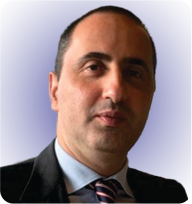In patients with joint hyperlaxity and glenohumeral instability with adequate bone block, the evaluation and reconstruction of the anterior capsulolabral tissues allows to avoid more invasive procedures.
Dr. Gianluca Fedeli, Department of Orthopaedic and Traumatology, Sant’Andrea Hospital, University of Rome “Sapienza,” Rome, Italy. E-mail: gianlucafedeli@gmail.com
Introduction: The treatment of chronic shoulder instability, associated with poor tissue quality, remains challenging in the setting of anterior capsular deficiency. There are a few viable alternatives in the end-stage shoulder instability when multiple surgical attempts to correct the pathology have failed. The purpose of the present paper is to demonstrate the efficacy of anterior capsular reconstruction with semitendinosus autograft for the management of capsulolabral deficiency without associated bone loss.
Case Report:A 39-year-old female admitted in our institution with a history of recurrent atraumatic anterior dislocation of the left shoulder after three unsuccessful surgical attempts: Arthroscopic and open capsulorrhaphy and a Latarjet coracoid transfer. CT scan images showed adequate placement (flush) of the coracoid transfer without any sign of reabsorption. Reconstruction of anterior capsulolabral structure was performed using a Semitendinosus autograft. The middle and inferior glenohumeral ligaments, the more crucial ligaments for anterior-inferior shoulder stability, were effectively recreated. The patient did not suffer any recurrent dislocation or subjective symptoms of instability at the time of the final follow-up, 2 years after surgery, and the ASES score increased from 36 preoperatively to 86.
Conclusion: This technique, described for the first time as a salvage procedure after Latarjet failure, could represent a safe and viable treatment option in the context of multiple ineffective surgeries.
Keywords: Autograft, capsulolabral reconstruction, latarjet, recurrent shoulder instability.
Anterior capsular deficiency management is a complex issue in patients with previous unsuccessful shoulder stabilization procedures. If the revision of multiple failed open or arthroscopic anterior capsulorrhaphy could commonly find a definitive solution with a Latarjet procedure [1], the failure of a bone block surgery might represent a difficult problem to solve. A viable option for end-stage shoulder instability is the reconstruction of injured anterior glenohumeral capsules and ligaments using anatomic [2, 3] and non-anatomic [4] techniques. For these techniques, the most reliable autograft/allograft choices, the appropriate open or arthroscopic technique, and proper post-operative rehabilitation remain unclear. The purpose of the current case report is to describe a patient who underwent a reconstruction of the injured anterior glenohumeral capsule and ligaments using semitendinosus autograft, leaving in place the bone block of a previous Latarjet procedure. To the authors’ best knowledge, this is the first case in which reconstruction of the anterior capsular ligaments with autologous semitendinosus transplantation has been performed after a failed Latarjet procedure.
A 39-year-old, left-hand-dominant female, presented in 2017 with a history of recurrent atraumatic anterior dislocation of the left shoulder after three unsuccessful surgical attempts. The patient described numerous episodes of atraumatic dislocation of the left shoulder. At the age of 14 (1993), she underwent arthroscopic capsulorrhaphy, with no persistent benefit; 2 years later (1995) she underwent an open capsulorrhaphy, with satisfactory regain of stability and functional recovery. Both interventions were performed in a different institution. However, in 2015, the patient reported a new episode of dislocation after having lifted a heavy object, followed briefly by further episodes of atraumatic dislocations. In 2016, the patient underwent a Latarjet procedure in a different institution with immediate unsatisfactory results due to persistent instability. Following this event, the patient began to complain of an occasional sensation of instability and nearly constant pain localized in the anterior region of the shoulder. She also reported three episodes of dislocation (Fig. 1). The patient presented to author’s orthopedic department in 2017. During the physical examination, she showed positive apprehension at 90° of abduction and the Jobe Relocation Test and Anterior Drawer Test were positive. She demonstrated positive apprehension with the arm in 90° of abduction during the physical examination. The Relocation Test, Anterior Drawer Test, and Sulcus sign were also positive. The evidence of characteristic signs of generalized ligament laxity was identified such as: hyperextension of the metacarpophalangeal joints, hyperabduction of the thumb, and recurvatum of the knees and elbows. The calculated Beighton [5] score was 8. The upper extremity did not show any sign of motor or sensory deficits. Pre-operative CT scan images showed adequate placement (flush) of the coracoid transfer without any sign of reabsorption (Fig. 2). After an intensive rehabilitation cycle lasting 6 months, due to the persistence of symptoms with impaired quality of life, an open revision surgery treatment was proposed to the patient.
With the patient in the supine position, a standard deltopectoral incision on the previous surgical scar was used to approach the glenohumeral joint. The subscapularis tendon was sectioned by teno-capsulotomy in line 1 cm medial to the bicipital groove, leaving about 10 mm of the tendon laterally for subsequent reinsertion. The subscapularis tendon and anterior capsule were meticulously split. Then, the subscapularis tendon was prepared with #2 FiberWire sutures (Arthrex, Naples, FL).

The glenoid neck was prepared to free the bone from any remaining soft tissue until a good exposure of the glenoid had been obtained. The bone block appeared to be in place, without any sign of reabsorption and integrated to the glenoid neck. Four suture anchors (bioabsorbable 3.0mm Bio-SutureTak; Arthrex, Naples, FL) were placed at the 2:00 O’clock, 3:00 O’clock, 4:00 O’clock and 5:30 clock positions (Fig. 3). These anchors positioned on the glenoid margin allow to secure the graft, to adequately reconstruct the glenoid labrum. Semitendinosus hamstring was harvested via a small incision along the pes anserinus and prepared at both ends with #2Fiberwire (Arthrex, Naples, FL). The autograft was then placed along the glenoid margin, allowing reconstruction of the labrum, and fixed with the anchor sutures starting from the center, then above and below toward the remaining anchors. The middle glenohumeral ligament (MGHL) and the anterior band of the inferior glenohumeral ligament (IGHL) were reconstructed using the two free ends of the autograft. The correct length of the graft was calculated by marking, with a demographic marker, the ends of the semitendinosus, which were lying on the insertion points previously marked on the humeral head. The anchor points on the humeral head of the reconstructed MGHL and IGHL ligaments were marked respectively at the upper and lower margin of the subscapularis tendon 5 mm medial to the bicipital groove (Fig. 4). This initial evaluation was carried out with the limb in the 30-30-30 position: 30° of anterior flexion, 30° of external rotation and 30° of abduction. This has been carried out to avoid over-constraining, which would in turn, increase the risk of joint stiffness. From the marked signs performed on the ST graft, an additional 1.5 cm of length was added: the latter would have been dragged into the anchor holes.

Using a 4.5 mm cannulated drill, two 2 cm deep holes were made, being careful to remain perpendicular to the entrance cortex, away from the articular margin. Subsequently the autograft was fixed on the humeral side (Fig. 5) using two suture anchors (SwiveLock 4.75 mm – Arthrex Naples, FL), while maintaining of the 30-30-30 position of the arm. Joint mobility was immediately tested with internal and external rotation movements. Afterward, residual joint capsule and subscapularis tendon were meticulously sutured and rotator interval closure was additionally performed. The shoulder was protected with a sling and swathe brace for 6 weeks following surgery. Assisted passive exercises for the recovery of range of motion started at 3 weeks. Six weeks after surgery, active exercises began with a limitation to 20° in external rotation. In the following weeks, rehabilitation was focused on recovering muscle strength with a gradual increase in external rotation. Twenty-four months after surgery, the patient reported no symptoms of instability, anterior pain, or episodes of dislocation. She was able to complete all activities of daily life in the absence of limitations. The ASES score [6] increased from 36 preoperatively to 86. On physical examination, the patient showed no anterior pain and the apprehension test was negative. She regained complete muscle strength measured by manual muscle testing. The jerk test and the anterior drawer test were equal to the unaffected contralateral shoulder. Range of motion evaluation showed: 110° anterior elevation, 20° external rotation with arm by the side, and 45° with the shoulder at 90° of abduction. Internal rotation reached the level of t8 (Fig. 6). There was no evidence of degenerative changes on X-ray.
Recurrence of dislocation is the most common complication following surgery for shoulder instability. When the surgeon is faced with a context of multiple failed stabilizations, the risk of recurrence increases exponentially up to 44% [7]. It has been described as an initial capsular lesion, over time, results in a progression of capsular insufficiency. The succession of these capsuloligamentous lesions is recognized as a determining factor in the recurrence of instability [8]. In cases of glenohumeral instability associated with a reduced glenoid surface, various anatomical and non-anatomical techniques [9] have been described to restore the bone stock. When the cause of the instability does not find its origin in the bone deficit, it is mandatory to look for the presence of lesions of the capsuloligamentous complex. In patients with joint hyperlaxity or who have undergone numerous gleno-humeral stabilization procedures, the quality of the capsulo-ligamentous tissue is poor. In the case under examination, the pre-operative CT scan showed adequate placement (flush) of the coracoid transfer of the previous Latarjet procedure without any sign of reabsorption (Fig. 2); therefore, the author’s main concern was about an anterior soft tissue deficiency. The treatment of chronic shoulder instability, associated with poor tissue quality, remains challenging in the setting of anterior capsular deficiency. There are a few viable alternatives in the end-stage shoulder instability when multiple surgical attempts to correct the pathology have failed. One choice for treating such an end-stage instability is gleno-humeral arthrodesis, this alternative should be considered when all other surgical options have already been evaluated and it is hardly acceptable for a young patient. Maiotti et al. [10], in a series of 89 patients who underwent combined Bankart repair and subscapularis augmentation tenodesis, reported three post-traumatic dislocations at the minimum 3-year follow-up. The mean deficit of external rotation was 6° with the arm at the side. Iannotti et al. [11] describe a technique that involves the use of an iliotibial band autograft or allograft to recreate the deficient anterior capsule-ligament structures of the shoulder. In the 4-year follow-up none of the seven patients included in the study reported new episodes of dislocation. Alcid et al. [2] reported of 15 patients (mean age, 30.9) with the previous failed gleno-humeral stabilization procedures. All patients underwent anterior capsular reconstruction with hamstring autograft or anterior tibial allograft. No dislocation episodes were reported in the 2-year follow-up. About one-third of patients reported persistence of symptomatic subluxation, remaining however satisfied with the surgery. Millet et al. [12] reported in 2012 a series of 15 patients (20 shoulders) with multiple failed stabilizations or collagen disorders who underwent reconstruction of anterior capsulolabral structures with tibialis anterior allograft or a semitendinosus autograft. Among treated patients, five had Ehlers-Danlos syndrome whereas ten had hyperlaxity syndromes without genetic confirmation. Recurrent instability (30%) requiring further stabilization occurred in six patients. Nonfailure patients were highly satisfied with their surgical outcomes. Millet et al. [12] reported a series of 15 patients previously treated with failed gleno-humeral stabilization procedures. The reconstruction of the anterior capsular structures of the shoulder was performed with hamstring autograft or anterior tibial allograft as in the series described by Iannotti and Alcid. These patients had an impaired quality of connective tissue, ten had hyperlaxity syndromes and five showed the Ehlers-Danlos syndrome. In the 4-year follow-up, approximately 30% of treated patients experienced a new episode of dislocation. Such a high recurrence rate is motivated by the intrinsic characteristics of the patients treated and therefore emphasizes the importance of diagnosing these connective tissue alterations before surgery. In 2018, Whelan et al. [13] reported an arthroscopic surgical technique to reconstruct the anterior capsular structures of the shoulder using human Acellular Dermal Allograft. The advantages of this technique are due to the faster recovery time and the absence of morbidity of the donor site compared to hamstring autograft. The negative aspects of this procedure are due to the increase in surgical times and the requirement of a high arthroscopic ability to perform the surgery. The previously described technique, similar to those proposed by Millett et al. [14] and Alcid et al. [2], is indicated in selected cases of anterior capsulolabral deficit. The use of hamstring tendon autograft allows a better tensioning of the graft and an anatomical reconstruction of the labrum. In addition, the most relevant ligaments for antero-inferior gleno-humeral stability, the MGHL and the IGHL, are effectively reconstructed with the correct tension (Fig. 4). The presented technique is contraindicated in cases of significant decrease in the bone stock (>20%), in the presence large and engaging Hill-Sachs defects or dislocation and/or reabsorption of the coracoid transfer of a previous Latarjet procedure. The described procedure can be performed with the use of different grafts: hamstring autograft, iliotibial band autograft, and tibialis anterior allograft according to the surgeon’s preferences. The use of hamstring tendon is a standardized procedure, frequently used for the reconstruction of acromioclavicular ligaments and ACL. It is important for the surgeon to carefully assess preoperatively the etiology and direction of shoulder instability, as multidirectional or posterior instability can worsen by addressing only anterior subluxation. This case underlines the importance of diagnosing the presence of collagenopathies or severe forms of generalized ligamentous laxity. In these patients the intervention is not precluded, in fact good results are reported by Millet et al. [12] in patients with collagenopathies; however, discussion of the procedure must be performed and the patient informed about the risk of recurrence.
The use of hamstring tendon autograft is an acceptable option in the management of the complex problem of capsular deficiency in anterior glenohumeral instability. This technique, described for the first time as a salvage procedure after Latarjet failure, could represent a viable treatment option in the context of multiple surgical failures. However, long-term monitoring of outcomes, particularly recurrent anterior instability and post-operative arthropathy should be monitored.
Reconstruction of anterior capsulolabral structure is a viable option for end-stage shoulder instability. This procedure, using the hamstring tendon, can be safely applied in the setting of a failed Latarjet coracoid transfer, avoiding much more invasive procedures such as glenohumeral arthrodesis.
References
- 1.Schmid SL, Farshad M, Catanzaro S, Gerber C. The Latarjet procedure for the treatment of recurrence of anterior instability of the shoulder after operative repair: A retrospective case series of forty-nine consecutive patients. J Bone Joint Surg Am 2012;94:e75. [Google Scholar]
- 2.Alcid JG, Powell SE, Tibone JE. Revision anterior capsular shoulder stabilization using hamstring tendon autograft and tibialis tendon allograft reinforcement: Minimum two-year follow-up. J Shoulder Elbow Surg 2007;16:268-72. [Google Scholar]
- 3.Warner JJ, Venegas AA, Lehtinen JT, Macy JJ. Management of capsular deficiency of the shoulder. A report of three cases. J Bone Joint Surg Am 2002;84:1668-71. [Google Scholar]
- 4.Gallie WE, Le Mesurier AB. Recurring dislocation of the shoulder. J Bone Joint Surg Br 1948;30:9-18. [Google Scholar]
- 5.Beighton P, Solomon L, Soskolne CL. Articular mobility in an African population. Ann Rheum Dis 1973;32:413-8. [Google Scholar]
- 6.Kocher MS, Horan MP, Briggs KK, Richardson TR, O’Holleran J, Hawkins RJ. Reliability, validity, and responsiveness of the American Shoulder and Elbow Surgeons subjective shoulder scale in patients with shoulder instability, rotator cuff disease, and glenohumeral arthritis. J Bone Joint Surg Am 2005;87:2006-11. [Google Scholar]
- 7.Levine WN, Arroyo JS, Pollock RG, Flatow EL, Bigliani LU. Open revision stabilization surgery for recurrent anterior glenohumeral instability. Am J Sports Med 2000;28:156-60. [Google Scholar]
- 8.Rodeo SA, Suzuki K, Yamauchi M, Bhargava M, Warren RF. Analysis of collagen and elastic fibers in shoulder capsule in patients with shoulder instability. Am J Sports Med 1998;26:634-43. [Google Scholar]
- 9.Matsen FA 3rd, Thomas SC, Rockwood CA Jr. Anterior glenohumeral instability. In: Rockwood CA Jr., Matsen FA 3rd, editors. The Shoulder. Philadelphia, PA: Saunders; 1990. p. 547-62. [Google Scholar]
- 10.Maiotti M, Russo R, Zanini A, Schröter S, Massoni C, Bianchedi D. Arthroscopic Bankart repair and subscapularis augmentation: An alternative technique treating anterior shoulder instability with bone loss. J Shoulder Elbow Surg 2016;25:898-906. [Google Scholar]
- 11.Iannotti JP, Antoniou J, Williams GR, Ramsey ML. Iliotibial band reconstruction for treatment of glenohumeral instability associated with irreparable capsular deficiency. J Shoulder Elbow Surg 2002;11:618-23. [Google Scholar]
- 12.Dewing CB, Horan MP, Millett PJ. Two-year outcomes of open shoulder anterior capsular reconstruction for instability from severe capsular deficiency. Arthroscopy 2012;28:43-51. [Google Scholar]
- 13.Whelan A, Coady C, Ho-Bun Wong I. Anterior glenohumeral capsular reconstruction using a human acellular dermal allograft. Arthrosc Tech 2018;7:e1235-41. [Google Scholar]
- 14.Braun S, Millett PJ. Open anterior capsular reconstruction of the shoulder for chronic instability using a tibialis anterior allograft. Tech Shoulder Elbow Surg 2008;9:102-7. [Google Scholar]











